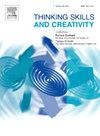Assessing novel techniques to promote creative cognition: Imaginative recategorization and context-dependent property generation
IF 4.5
2区 教育学
Q1 Social Sciences
引用次数: 0
Abstract
Creativity is often the key to enhancing experience and improving outcomes in professional pursuits and everyday life, however it can be difficult to achieve. A mental set restricts people to considering only standard approaches or obvious aspects of a situation and thereby blocks potential creativity. The present study addresses two novel and relatively lightweight interventions to encourage participants to extend beyond their default concepts of task-relevant objects. Imaginative recategorization invites participants to consider an object in a novel role by considering its potential membership in a familiar category that violates traditional taxonomic status. Context-dependent property generation focuses participants on activating properties of an object that only become obvious when situated in a particular context. Participants were given a short training and then completed the Alternate Uses Task (AUT) and Make a Creature (MAC) creativity tasks with a guided application of each learned technique to problem-relevant objects. In the control condition, participants instead completed a free-association exercise starting from a problem-relevant object before completing the same two creativity tests. The Make a Creature task did not lead to reliable differences, however the AUT showed that imaginative recategorization increased cognitive flexibility, with decreased usefulness of responses. Results reveal the value and limitations of the proposed techniques to break out of mental sets and achieve creative cognition by inviting new pathways between problem-relevant objects, their categorizations, and the inference of category properties.
评估促进创造性认知的新技术:想象重新分类和情境依赖属性生成
在职业追求和日常生活中,创造力往往是增强经验和改善成果的关键,但这很难实现。思维定势限制了人们只考虑标准方法或情况的明显方面,从而阻碍了潜在的创造力。本研究提出了两种新颖且相对轻量级的干预措施,以鼓励参与者超越他们对任务相关对象的默认概念。想象重新分类邀请参与者考虑一个对象在一个新的角色,通过考虑其潜在的成员在一个熟悉的类别,违反传统的分类地位。上下文相关的属性生成使参与者专注于激活对象的属性,这些属性只有在处于特定上下文中时才会变得明显。参与者接受了短暂的培训,然后完成了替代使用任务(AUT)和制作生物(MAC)创意任务,并指导将每种学习的技术应用于与问题相关的物体。在控制条件下,参与者在完成同样的两个创造力测试之前,先完成一个从与问题相关的物体开始的自由联想练习。“制造一个生物”任务并没有导致可靠的差异,但AUT显示,想象重新分类增加了认知灵活性,降低了反应的有用性。结果揭示了所提出的技术的价值和局限性,通过在问题相关对象、它们的分类和类别属性的推断之间引入新的途径来打破心理定式,实现创造性认知。
本文章由计算机程序翻译,如有差异,请以英文原文为准。
求助全文
约1分钟内获得全文
求助全文
来源期刊

Thinking Skills and Creativity
EDUCATION & EDUCATIONAL RESEARCH-
CiteScore
6.40
自引率
16.20%
发文量
172
审稿时长
76 days
期刊介绍:
Thinking Skills and Creativity is a new journal providing a peer-reviewed forum for communication and debate for the community of researchers interested in teaching for thinking and creativity. Papers may represent a variety of theoretical perspectives and methodological approaches and may relate to any age level in a diversity of settings: formal and informal, education and work-based.
 求助内容:
求助内容: 应助结果提醒方式:
应助结果提醒方式:


